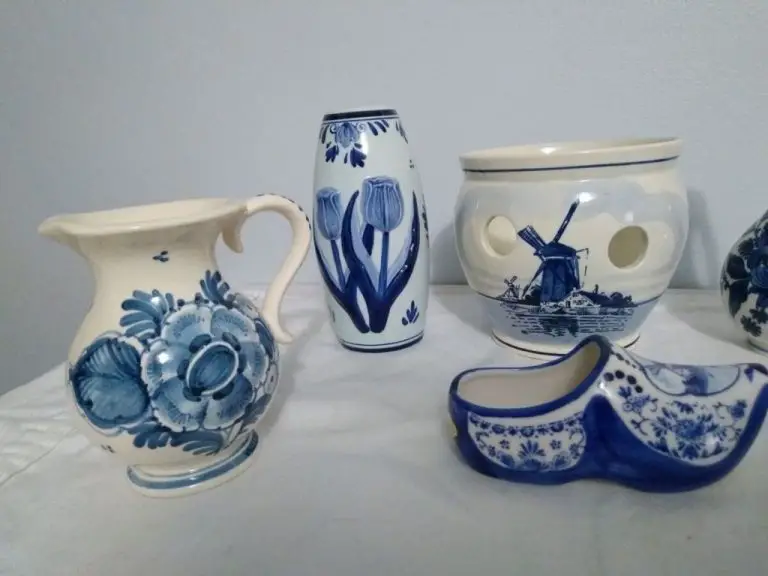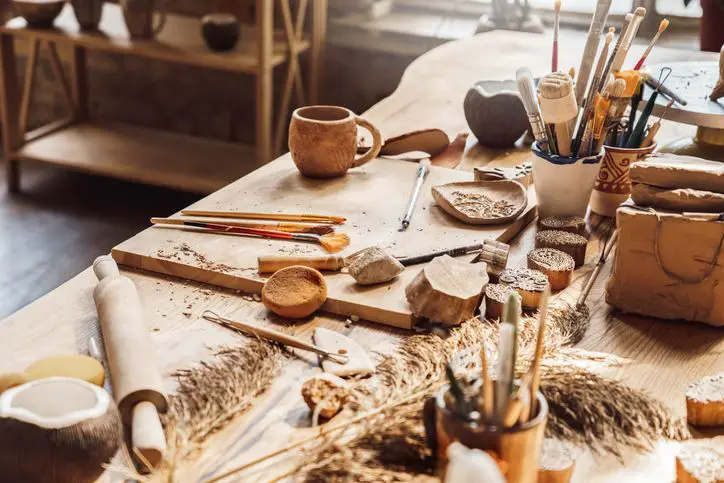Where Did Coil Pottery Originate?
Coil pottery is a handbuilding technique used to create ceramic vessels by rolling out ropes or coils of clay and stacking them on top of one another to build up the shape. The coils are smoothed together using fingers, paddles or tools to bond them. Coil pots likely emerged as early potters sought techniques to build larger, more stable vessels than pinch pots allowed.
Evidence of coil-built pottery dates back over 20,000 years in East Asia and Japan. In the Americas, the earliest known coil vessels were made around 2500 BCE in southwestern United States and Mexico. Over thousands of years, coil techniques spread through trade routes and evolved into refined regional styles. Today, coil building remains a fundamental ceramic construction method used by traditional and contemporary potters worldwide.
Earliest Examples
The earliest known examples of coil pottery come from the Jomon period in Japan, dating back to between 14,500 – 300 BCE. Coil-made pottery shards have been found at numerous Jomon sites, indicating it was a widespread technique at the time.
There is evidence that coil pottery may have originated even earlier in parts of Asia, Africa and the Americas, with pottery remnants possibly dating back over 20,000 years. However, the confirmed coil pottery from Jomon period Japan provides the definitive proof and examples of this technique being used in an advanced way at such an early time.
According to archaeological research, the oldest coil-pottery shards from the Initial Jomon period were smooth and basic; later Jomon pottery shows more advanced coil techniques and surface decoration like thumbnail marks.
Spread Through Trade
Coil pottery originated during the Neolithic period over 10,000 years ago. It was first popularized in ancient Mesopotamia and Egypt where clay was abundant. From there, it spread via established trade routes to cultures all across Europe and the Middle East. Traders and merchants carried coil pots on ships and caravans to sell. This allowed diverse civilizations to adopt the coiling technique for making their own locally produced pottery. Evidence of coil built ceramics has been found at archaeological sites of ancient Greek, Roman, Persian, and Chinese origin. While styles and decorations varied by region, the fundamental process of coiling and scraping clay remained consistent. The portability of coil pots made them ideal for transporting goods by land and sea, thus driving their proliferation across the ancient world.
Refinements Over Time
As coil pottery techniques spread to new regions over thousands of years, artisans gradually refined their methods and tools. According to The History of Coil Pottery in the Southwest United States, the invention of the pottery wheel enabled more uniform and thinner vessel walls.
Glazes and decorative techniques also evolved over centuries. Colorful mineral glazes emerged in China as early as the 14th century BCE based on archaeological evidence, transforming the look of coil vessels. In the Americas, Native artisans developed slip painting, in which mineral pigments are mixed into liquid clay slip then applied to leather-hard pots. This produced intricate black-on-white motifs on Southwestern ceramics.
As civilizations innovated new tools and aesthetics, they elevated coil pottery into higher artforms suitable for ritual and ceremony. Overall, the centuries-long refinements reflect the creativity and skill of diverse cultures across the world.
Regional Variations
As coil pottery spread across different regions over thousands of years, unique styles emerged based on the available local materials.https://ancientpottery.how/history-of-coil-pottery/ In the American Southwest, potters used clay mixed with crushed rock or sand which turned the vessels grey or red after firing. These early Southwest pots were often decorated with bold black geometric designs.https://thepotterywheel.com/historical-coil-pots/
In West Africa, dark clay rich in iron and manganese created very dark vessels, sometimes with a bluish cast. These were built up with ropes of clay and then shaped into elegant globular forms.https://ceramike.com/southwest-coil-pottery-a-history/ Local cultural influences also shaped the aesthetic, with some African coil pots featuring small heads or figures attached.
So while the basic coiling technique spread widely, regional artisans adapted it using local clays, mineral pigments, and cultural motifs to create distinctive styles.
Revival in Modern Era
Coil pottery experienced a revival in the late 19th century during the American art pottery movement. As art schools and pottery studios spread across the country, many ceramic artists turned to ancient techniques like coiling to create their works.
One of the most well-known artists was Clara Shapiro, who operated the Clarabella Pottery studio in California from 1911-1972. Shapiro specialized in coil pots, jars, and vessels, often with decorative brushed designs. She helped popularize coil building among 20th century studio potters. Other influential artists who worked in coiling include Adelaide Alsop Robineau and Maria Martinez.
According to The History of Coil Pottery in the Southwest United States, “the art pottery movement at the turn of the century rekindled interest in coil-built ceramics across the country.” Coil pots were exhibited and collected by major museums, helping raise the profile of coiled vessels as works of art.
Contemporary Artists
Coil pottery remains an active technique used by contemporary ceramic artists around the world. Some notable coil potters today include Magdalene Odundo, Gordon Baldwin, and Grayson Perry.
Odundo is known for her elegant vessels with undulating rippled surfaces, often left unglazed to showcase the natural clay [1]. Baldwin creates abstract sculptural pieces, pushing the boundaries of traditional coiling with complex shapes and textures [2]. Perry employs coiling in his highly detailed narrative pots which depict satirical scenes.
These contemporary artists take advantage of modern tools, glazes, and Kilns to create innovative work. Odundo fires her pieces in an anagama-style Japanese wood-burning kiln to over 2000°F to produce ashen hues. Baldwin experiments with metallic glazes for shimmering surfaces. The evolution of pottery wheels, specialized modeling tools, and glaze materials allows today’s coil potters to advance the technique.
Coiling Technique
The coiling technique is the fundamental process used to create coil pots. It involves rolling clay into long ropes or coils, then stacking and smoothing the coils together to form the pot’s shape. Here are the basic steps:
1. Knead and wedge the clay. Kneading removes air bubbles and wedging aligns the clay particles, making the clay smooth and cohesive for coiling.
2. Roll out clay coils. Use your hands or a rolling pin to roll clay into long, rope-like coils, roughly 1/4″ to 1/2″ thick. Keep the thickness consistent.
3. Build up the base. Roll a flat, circular base for your pot. Create the pot’s walls by stacking coils vertically around the base. Apply water or slip between coils to help bond them.
4. Smooth the coils. Use your fingers, a modeling tool, or a rib to blend the coils together and smooth the interior and exterior walls. Go slowly to avoid tearing.
5. Refine the shape. Once the coils are blended, refine the pot’s shape as desired. Add any decorative elements, handles, spouts, etc.
6. Allow to dry and fire. Let the pot air dry completely before firing it in a kiln. Firing will harden and strengthen the clay.
Helpful tips for coiling: Store unused coils in plastic bags so they don’t dry out. Maintain consistent coil thickness and overlap coils at a slight angle for stability. Add coils vertically and use gentle pressure to bond – don’t drag or stretch the coils. Check for cracks and gaps as you build, filling any with slip or extra clay.
For a step-by-step tutorial with photos and videos, see this excellent guide on how to make coil pots.
Cultural Significance
Coil pottery has played an important cultural role in many ancient societies around the world. In the American Southwest, coil pots were central to the lives of Native American groups like the Anasazi, Mogollon, and Hohokam. These groups produced coil pots for utilitarian purposes like cooking and storage, but the pots also held deeper meaning. Intricately decorated vessels were used in religious rituals and ceremonies, given as gifts at weddings and births, and buried with the dead as grave goods (The History of Coil Pottery in the Southwest United States).
In Africa, coil pots have an equally long history. Archaeologists have uncovered coil-made pots in North Africa dating back to 7000 BCE. Coiling was the dominant technique across the continent for thousands of years. African coil wares are admired for their elegantly rounded and tapered forms. Designs and surface treatments not only beautify the vessels but often have symbolic meanings. Coil pots continue to hold significance in many African cultures today, used in ceremonies, given as gifts at important life events, and seen as expressions of cultural heritage and identity (Southwest Coil Pottery: A History – Ceramike).
Though coil pottery declined with the introduction of the pottery wheel, it remains an important tradition in many parts of the world. Contemporary Native American and African artists keep their ancestral coil techniques alive by creating new interpretative works. Coil pots retain deep cultural meaning as representations of history, community, and shared experiences across generations.
Conclusion
Coil pottery has a rich history spanning thousands of years. Originating in Central America around 2000 BCE, the technique slowly spread northward over many centuries, eventually reaching the American Southwest. Though early examples were simple and utilitarian, intended for everyday use, coil techniques were refined over time, allowing for thinner walls and more intricate surface designs. Regional styles emerged, with beautiful multicolored glazes and decorative patterns. While the coil method declined after European contact, it underwent a revival in the 20th century as contemporary Native American artists returned to the traditional roots of their ancestors. Today, coil pots and vessels are admired not just for their beauty and artistry, but for their lasting legacy as an ancient, storied pottery technique deeply rooted in the cultures of the Americas.
In summary, coil pottery originated many millennia ago in Mesoamerica, gradually migrated northward, and evolved over thousands of years into a diverse array of regional pottery styles before being revived by modern artists seeking to preserve ancient cultural traditions. The longevity and adaptability of coil techniques is a testament to the skill and creativity of generations of potters across the Americas.




